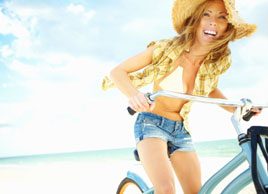How to make biking more comfortable
Try these solutions to make your next bike ride a more comfortable one

Source: Photo credit: © iStockphoto
Biking rules! You zip through about 500 calories per hour doing moderate cycling ‘ more when you’re pumping up a hill. You can fly all over town, running your errands (all you need is a basket, a pannier or just a good backpack) while doing something good for your health and the environment.
But there’s a catch: when men and women spend too long in the biking saddle it can hurt. Down there. Pressure and friction from a bike seat can cause genital irritation, pain and maybe even medical problems.
‘It’s definitely a big issue,’ says Dr. Michael Weir, a Peterborough-based urologist. ‘But whether bike seats cause problems or just irritate existing problems, we’re not sure.’
There’s been just a handful of good medical studies done on bike seats and health problems. But with the push for bike lanes, the popularity of spinning fitness classes and more professionals such as police officers riding bikes, that may change. And not soon enough for those of us who love to ride for sport, fun or transportation.
The problem
‘The perineum area of the body was not designed to bear weight,’ says Steven Schrader, who has done studies on police officers and bike seats as team leader of the reproductive health assessment team at the National Institute for Occupational Safety and Health in the U.S.
When we bike, we put as much as half our body weight right on that perineum (the body part between the sexual organs and our anus), and the nerves and blood vessels to the penis or testicles for men and labia and clitoris for women get compressed.
The result: irritation for starters. Professional cyclists get saddle sores ‘ painful welts in the genital area and buttocks because of chafing. For men, riding is linked with erectile dysfunction. A 2005 study found that cyclists were more likely to have ED than swimmers or runners and biking for more than three hours dramatically increased that risk.
As well, cycling irritates prostate problems and cycling for long periods at a time can lead to pain, tingling and soreness for many men.
For women, chafing of the labia and clitoris can lead to pain and sexual dysfunction. Dr. Curtis Nickel, professor of urology at Queen’s University, treats people with pelvic pain. He says that for women who have any kind of existing issue ‘ pelvic pain afflicts 10 percent of women and is caused by conditions such as endometriosis and pelvic floor dysfunction ‘cycling can be very uncomfortable. Add in vaginal dryness or a yeast or urinary tract infection and you could have pain after a ride.
The solution
‘We advise patients who have pain to avoid cycling and take up another low impact sport like speed walking,’ says Dr. Nickel. ‘Or find a seat that fits their bottom and does not cause trauma.’
If you don’t want to drop cycling altogether (who would? It’s a great sport!) but you have pain problems, here are some solutions:
Wear shorts
Padded, seamless cycling shorts cushion your underside and have special air vents to keep things dry. To work, shorts must fit super tight, be worn without underwear and be taken off right after you cycle. Dr. Nickel says there are numerous brands on the market and every cyclist he’s spoken to swears by a different brand: you just have to try a few.
Cream up
Products like Chamois Butt’r are designed to help groin area chafing. They’re best used with biking shorts, but you can use them in your regular clothes too. A cream won’t reduce pressure on blood vessels and nerves, but it will help with chafing.
Go seat shopping
The wall of your local bike store is full of different seats ‘ for good reason. ‘We are all different and what is comfortable for one is not for another,’ says Schrader.
Dr. Nickel likes wider seats: they put more weight on the buttocks. Meanwhile, cutaway seats, which have a hole in the middle, help keep pressure off key nerves and blood vessels. There are also leather seats, which breathe nicely, and gel seats which offer a cushy ride. The only way to find out what works for you is to try an array. That can get expensive so try out seats on others’ bikes too.
Go noseless
A new generation of bike seats has lobbed the nose portion of the seat right off. These seats operate more like a chair, with just your buttocks on the seat and the genital area getting minimal contact. Products like the Canadian-made Spongy Wonder reduce pressure on the pelvic region by about 65 percent. They solve the pain problem, but they do change the way you cycle and may put more pressure on your arms. Schrader’s studies with police officers found that different officers liked different noseless brands and had to try several before getting the right fit.
Adjust your bike
A 2012 study published in The Journal of Sexual Medicine found that in a group of 48 female professional cyclists, raising the handlebars decreased pressure on the genitals and increased sensation. Makes sense: when you sit up more, you’re on your buttocks, not stopping blood flow at your perineum.
As well, having the nose of your seat pointed up is a no-no. ‘If the saddle is pointed upward it will put more pressure on the perineum,’ says Schrader.
Making sure your bike overall fits you well and then tinkering with the heights and angles of its components is yet one more way you can save your underside.
Don’t miss out! Sign up for our free weekly newsletters and get nutritious recipes, healthy weight-loss tips, easy ways to stay in shape and all the health news you need, delivered straight to your inbox.




